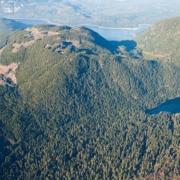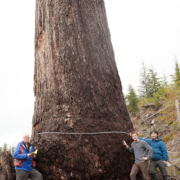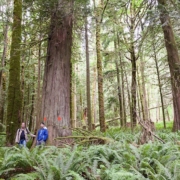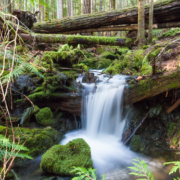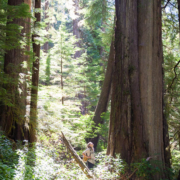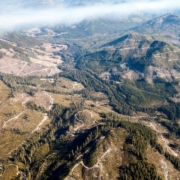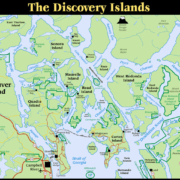Things YOU can DO right now:
1. Take 30 seconds and “SEND a MESSAGE” to make your voice heard to BC’s politicians at: www.BCForestMovement.com
2. By 12 noon on May 30, be sure to write-in to the official input process (but don’t limit yourself to this flawed process). Write to Jim Snetsinger, public engagement coordinator on TFL expansion, at: forest.tenures@gov.bc.ca See the official government website on participating on their Blog site at: https://engage.gov.bc.ca/foresttenures/
Let them know that you:
– Oppose any move to expand Tree Farm Licences (TFL’s) in BC. TFL-expansion would increase the property rights for BC’s largest logging companies over public forest lands and undermine new forest protection measures, First Nations treaty settlement, and remove land that could be used to diversify forestry in BC for communities and smaller operators. Tree Farm Licences increase the compensation rights – to be paid by BC taxpayers – to private logging companies if significant new protected areas or First Nations treaties are settled on those public lands. This would make it more lengthy and difficult to settle land claims and protect forests for tourism, recreation, and biodiversity.
– Dispute the notion that Tree Farm Licences act as incentives for companies to treat the land in an environmentally-sustainable manner. Major logging companies are not communities – they are highly mobile, regularly buy and sell their TFL’s every few years, and are not tied to the land or to the area’s scenery, water quality, wild salmon, biodiversity, or tourism/recreational qualities. BC’s TFL’s are replete with examples of overcut forests, major soil erosion, destroyed salmon-spawning streams, locked gates, and the massive depletion of old-growth forests.
– Believe the BC government’s “consultation process” is flawed due to being framed around the question of “how” to expand Tree Farm Licences instead of “whether or not” this should be done. It also only lists “potential benefits” of TFL’s but no “potential problems”.
– Want the BC government instead to increase protection of BC’s overcut forests for all values and users – for endangered species, scenery, tourism, clean water, wild salmon, and long-term sustainable employment for forestry dependent communities.
3. Write Letters to the Editor, phone-in to radio programs, forward to your email contacts, share on Facebook and Twitter, and help get the word out!
***MORE INFO***
In April, the BC Liberal government revived their proposal to allow major logging companies to receive exclusive logging rights over vast areas of public forest lands through the expansion of Tree Farm Licences. Despite being killed by widespread public opposition in 2013, they’ve resurrected this “forest giveaway scheme” like a zombie, in a bid to increase property rights for timber corporations on our public lands. These lands are vital for wildlife, recreation, scenery, clean water, wild salmon, First Nations, and small forestry operators.
This proposal would make it harder to protect forests, settle First Nations land claims, and diversify forestry in BC in a way that truly supports forestry-dependent communities. Ultimately, it will further entrench the status quo of massive overcutting in BC by large corporations that is resulting in the collapse of human communities and ecosystems – a process well-advanced on BC’s southern coast, and now underway in BC’s interior.
What is a Tree Farm Licence?
A Tree Farm Licence (TFL) is a defined geographic area that is tens or hundreds of thousands of hectares in size that confers exclusive logging rights to one logging company on public (Crown) land. TFL’s currently constitute a small fraction of BC, about 15% of the province’s cut. Most of the province’s forests are found in Timber Supply Areas (TSA’s) where no specific geographic area is granted to one company for exclusive logging rights – instead many companies within each large TSA are each given a volume of wood (in cubic meters) through a Forest Licence (FL) to cut, as are a diversity of smaller companies and First Nations through other types of licences and Timber Sales.
A Rigged Consultation Process
While now gently billed as a “consultation process” regarding “area-based tenures” – which evokes images of Community Forests and family-run Woodlots – in reality the government’s proposal primarily aims to allow large companies that already have major “volume-based licences” (ie. Forest Licences) to convert them into Tree Farm Licences: “The Province is looking at options to convert some or a portion of some volume-based forest licences to new or expanded area-based tree farm licences” (BC Government’s “Discussion Paper: Area-Based Forest Tenures”, page 11).
In BC, only five major companies have been allocated two-thirds of the allowable cut under replaceable Forest Licences, meaning these large companies stand to primarily benefit from this scheme at the exclusion of others. Any expansion of small tenures like Community Forests, if it happens, would be very minor in comparison – they would primarily be used as a Trojan horse in an effort to placate public discontent, behind which the much larger corporate forest land giveaway would occur.
The scope of the new consultation is a rigged process that doesn’t ask “whether” or not Tree Farm Licences should be expanded, but instead asks “how” they should be implemented. The BC government’s Discussion Paper only lists “Potential Benefits” but no “Potential Problems”. Its starting assumption is that companies with volume-based licences should and will be allowed to convert them into Tree Farm Licences in regions throughout BC.
Despite the government’s attempts to downplay the proposal’s geographic extent – as if it will be limited to only pine-beetle affected regions (which is still an enormous part of the province) – their wider ambitions are revealed in their Discussion Paper: “Initially, these opportunities would be limited in number and would only be available in areas impacted by the mountain pine beetle. Over time, they could be offered in other parts of the province.” (BC Government’s “Discussion Paper: Area-Based Forest Tenures”, page 11)
Undermining Forest Protection and First Nations Land Claims
A core reason for the drive to expand Tree Farm Licences is to enhance the major logging companies’ claims to compensation and to undermine potential forest conservation measures (for fish and wildlife habitat, recreation, old-growth forests, endangered species, scenery, tourism, etc.) and First Nations treaties. Protected areas and First Nations land claims pose the main sources of “uncertainty” to the logging companies’ access to the remaining public timber supply. Again, the BC government makes this clear:
“The major benefit of such a change is the increased certainty of timber supply that an area-based tenure would apply to the licence holder.” (page 10, Discussion Paper: Area-Based Forest Tenures )
and
“The licence holder is compensated if the allowable annual cut of the licence is reduced by more than 5 per cent as a result of Crown land deletions.” (page 8, Discussion Paper: Area-Based Forest Tenures)
Not only would it be more expensive and difficult to establish provincial parks and conservancies (First Nations-orientated protected areas), the politics of Tree Farm Licences could also undermine new “forest reserves” or regulatory protections like Riparian Management Zones, Wildlife Habitat Areas, Ungulate Winter Ranges, Old-Growth Management Areas, Visual Quality Objectives, and Recreation Areas. The BC government is considering opening up forest reserves in the Central Interior in order to allow companies to continue overcutting our forests for a few more years – until the inevitable crash. It’s like burning up parts of your house for firewood after unsustainably squandering all your other wood sources. If forest reserves are removed, it could be politically more difficult to re-establish forest protections once companies are awarded Tree Farm Licences on those lands, as their expectations to exercise their logging rights within their defined geographic areas would be enhanced with their exclusive access rights.
The Myth of Tree Farm Licences Promoting Sustainability – Countless Examples of this Falsehood
The BC government propagates the myth that increased corporate control on public lands fosters better stewardship and greater sustainability in their Discussion Paper: “With area-based forest tenures, it is in the best interests of the licence holder to ensure the long-term sustainability of the area to secure future harvests.” (BC Government’s “Discussion Paper: Area-Based Forest Tenures”, page 8).
In reality, BC’s Tree Farm Licences are bought and sold frequently by highly mobile companies that themselves frequently change ownership. These big companies are not tied to the land like communities are, they are not looking at the long term. Nor is it in their financial interest to manage the forests for biodiversity, recreation, water quality or wild salmon, as they don’t make money from such things – they make money from the timber alone. Some of the province’s most notorious, internationally famous examples of massive clearcutting, overcutting, landslides, destruction of salmon streams, annihilation of old-growth forests, locked gates, and ruined scenery and recreational opportunities are in the province’s Tree Farm Licences.
Rewarding Corporations for Overcutting BC’s Public Forests
Recently, two of the BC Interior’s major companies, Canfor and West Fraser, overcut almost a million cubic meters of live green timber where they were supposed to be only taking beetle-killed wood. Incredibly, the companies were let off the hook by Forest Minister Steve Thomson without penalties.
Instead of penalizing companies that are overcutting our forests, this government is now looking to potentially reward them by further entrenching their unfettered access to vast tracts of public forest lands through new Tree Farm Licences.
This is the BC Liberal government’s attempt to facilitate the last great timber grab by the major companies to log until the end of the resource – at the expense of communities and ecosystems. Only a large-scale, broad-based mobilization of British Columbians who speak up can stop this corporate land grab in BC.
Sustainable Forestry Needed – Slower, Value-Added, Diverse
With employment in BC’s forest industry now almost half of what it was a couple decades ago due to resource depletion (ie. cutting too much, too fast, of the biggest, best trees in the easiest to reach lower elevations), industry deregulation, corporate concentration, raw log exports, and mechanization, the BC Liberal government must have the wisdom and courage to implement real solutions. Reducing the grossly unsustainable rate of cut, promoting value-added manufacturing through incentives and regulations, providing access to forests and logs for a greater diversity of smaller and community-based forestry operations in BC, restricting raw log exports, diminishing wood waste, and protecting and conserving more endangered forests, are all needed. Increasing corporate control over the land base, obstructing new forest protections, and helping to entrench further overcutting for a few more years, are the last things BC needs.

